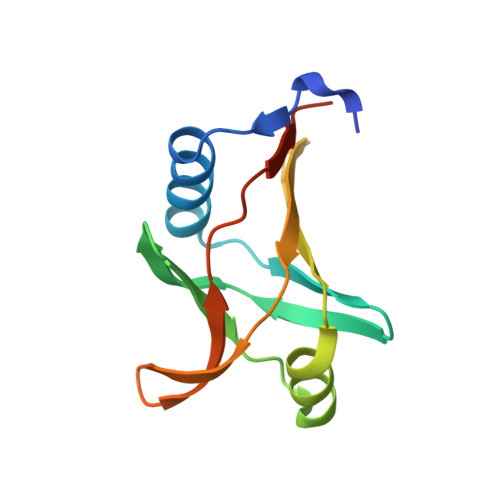Structural insights into the mechanism of c-di-GMP-bound YcgR regulating flagellar motility inEscherichia coli.
Hou, Y.J., Yang, W.S., Hong, Y., Zhang, Y., Wang, D.C., Li, D.F.(2020) J Biol Chem 295: 808-821
- PubMed: 31836667
- DOI: https://doi.org/10.1074/jbc.RA119.009739
- Primary Citation of Related Structures:
5Y6F, 5Y6G, 5Y6H - PubMed Abstract:
The motile-sessile transition is critical for bacterial survival and growth. Cyclic-di-GMP (c-di-GMP) plays a central role in controlling this transition and regulating biofilm formation via various effectors. As an effector of c-di-GMP in Escherichia coli and related species, the PilZ domain-containing protein YcgR responds to elevated c-di-GMP concentrations and acts on the flagellar motor to suppress bacterial motility in a brakelike fashion, which promotes bacterial surface attachment. To date, several target proteins within the motor, MotA, FliG, and FliM, along with different regulatory mechanisms have been reported. However, how YcgR acts on these components remains unclear. Here, we report that activated YcgR stably binds to MotA at the MotA-FliG interface and thereby regulates bacterial swimming. Biochemical and structural analyses revealed that c-di-GMP rearranges the PilZ domain configuration, resulting in the formation of a MotA-binding patch consisting of an R XXX R motif and the C-tail helix α3. Moreover, we noted that a conserved region in the YcgR-N domain, which is independent of MotA interaction, is necessary for motility regulation. On the basis of these findings, we infer that the YcgR-N domain is required for activity on other motor proteins. We propose that activated YcgR appends to MotA via its PilZ domain and thereby interrupts the MotA-FliG interaction and simultaneously interacts with other motor proteins via its YcgR-N domain to inhibit flagellar motility. Our findings suggest that the mode of interaction between YcgR and motor proteins may be shared by other PilZ family proteins.
Organizational Affiliation:
National Laboratory of Biomacromolecules, CAS Center for Excellence in Biomacromolecules, Institute of Biophysics, Chinese Academy of Sciences, Beijing 100101, China.














